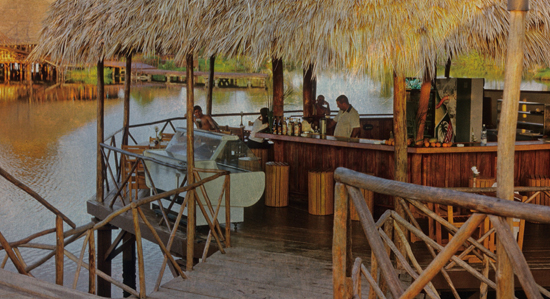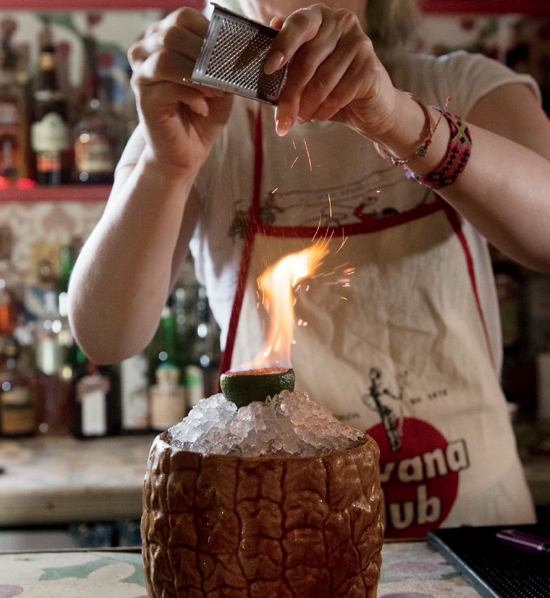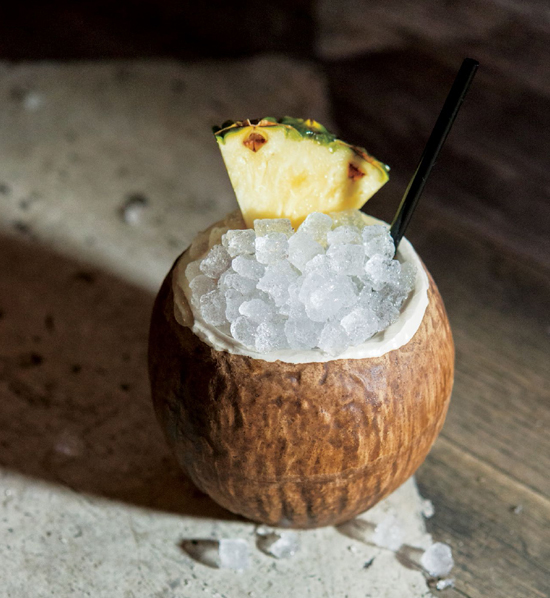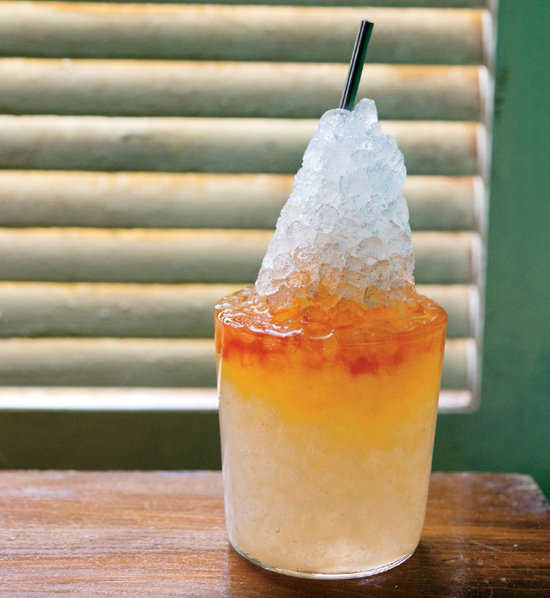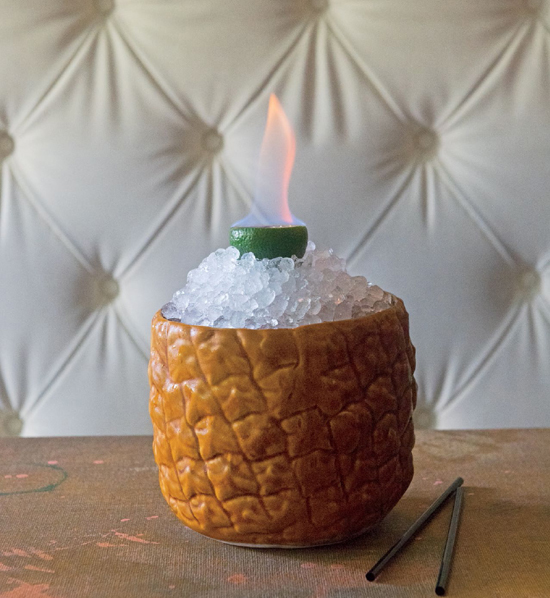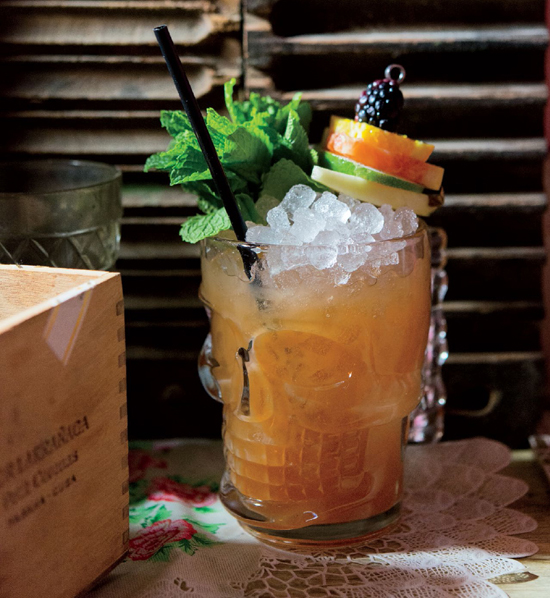THE TIKI & THE COLD WAR
The Cold War transformed the globe into a potential battleground between the USA and the USSR. Nowhere was safe—not even the Caribbean. These drinks deliciously capture the heady anxiety of that time.
TIKI DRINKS
Donn Beachcomber created the tiki family of drinks by amalgamating the experiences of his travels abroad. The style has firm roots in Polynesia, but the base of the cocktails appears in Cuban and other Caribbean classics. Donn Beachcomber called his drinks Rhum Rhapsodies, and many people replicated them, most notably Trader Vic.
In March 1958, Conrad Hilton opened the Habana Hilton, the tallest and largest hotel in the area, which boasted a Trader Vic’s bar and restaurant. On January 8, 1959, Castro entered Havana in triumph and made the hotel his headquarters. But that was only the beginning of the tensions between Cuba and U.S. business interests. By October 1960, Castro had completed the nationalization of all American-owned property in Cuba, prompting a retaliatory trade embargo. In April of the following year, the White House sponsored the disastrous Bay of Pigs invasion to topple Castro, who thereafter suspected America of similar plots to overthrow him. In April 1962, the Kennedy administration deployed nuclear missiles to Turkey—within easy striking distance of Moscow. In turn, Soviet premier Nikita Khrushchev accepted Castro’s invitation to deploy nuclear missiles to the island nation to act as a deterrent.
As the world teetered on the brink of total annihilation, the exotic allure of tropical drinks grew in parallel with the tensions of the Cold War. Unable to blow off steam safely in the Caribbean, Americans began creating these exotic cocktails in their own backyards.
PIÑA COLADA
Piña colada means “strained pineapple” in Spanish, and Ramon “Monchito” Marrero y Perez reportedly created this version in 1954 at the Caribe Hilton in Puerto Rico. This is the Puerto Rican version of the drink, made possible with the advent of Coco Lopez (page 204).

TIKI BOWL
2 OUNCES WHITE RUM
3 OUNCES COCONUT PUREE
1 OUNCE SIMPLE SYRUP (PAGE 10)
2 OUNCES PINEAPPLE JUICE
½ CUP CRUSHED ICE
PINEAPPLE FOR GARNISH
Combine all ingredients in a blender, and blend for 15 seconds. Pour into a tiki bowl or frozen pineapple shell. Garnish with a pineapple wedge or a cocktail umbrella. For more of a kick, whip shake ingredients and serve over crushed ice.
To make the Cuban version, omit the coconut puree and add ¾ ounce lime juice.
 NOTE
NOTE 
Turn the page for more about the history of the Piña Colada in Cuba.
PIÑA COLADA DE CUBA
Sailors on Christopher Columbus’s second voyage to the New World encountered a new fruit that resembled a giant pinecone. They called it a piña and brought it back to Europe. Soon after, the pineapple became a symbol of wealth and hospitality.
The original incarnation of El Floridita in Havana was as La Piña de Plata, where the house specialty was pineapple juice. But wherever pineapples grow, they’re often combined with rum. Served ice cold, jugo de piña con ron (pineapple juice with rum) became fashionable during the tourism explosion that occurred in Cuba after the Spanish-American War. The first written reference to a piña colada comes from a 1922 Travel magazine article about “Cuba’s Vivacious Metropolis.” The author describes this refreshing drink as a mixture of pineapple juice, sugar, rum, and lime juice. Over time, this version has become known as the Cuban Piña Colada, but it continues to evolve. A decade later, in Bar La Florida Cocktails, the Havana Beach cocktail consists of pineapple juice, sugar, and rum.
DEMERARA DRY FLOAT
Demerara rums are noted for their dark, smoky, slightly burnt aromas, but the refreshing, tangy passion fruit syrup and nutty, sweet maraschino liqueur in this drink tame the bold rum—before its blazing overproof relative goes to work. Created by Donn Beachcomber around 1941, this lost tiki treasure makes a comeback.

SWIZZLE GLASS
1 OUNCE EL DORADO 5 YEAR RUM
1 TEASPOON MARASCHINO
½ OUNCE PASSION FRUIT SYRUP (PAGE 11)
1 TEASPOON SIMPLE SYRUP (PAGE 10)
1 OUNCE LIME JUICE
HAMILTON 151 RUM TO SERVE
PINEAPPLE FOR GARNISH
Swizzle all ingredients except the 151 in a swizzle glass with crushed ice. Top with 1 barspoon of flaming 151 rum. Garnish with pineapple wedge.
 NOTE
NOTE 
Although it’s not a demerara rum, you can also use Gosling’s 151, made from molasses.
Lemon Hart 151 long was the preferred rum for this recipe. In 1720, Abraham Hart, a German, got into the rumbullion trade in the Caribbean and, with an eye on the market, later relocated to Penzance in Cornwall on the western tip of England. Half a century later, his grandson Lehman “Lemon” Hart joined the family business and for his efforts became the first producer to officially supply the British Royal Navy with the spirit. The rum that bears his name has gone in and out of production, and we hope to see it on shelves again soon.
DONN BEACHCOMBER
As a child, Ernest Gantt spent winters aboard his grandfather’s yacht in the Caribbean, exploring the old bars of Haiti and Havana and taking part in his grandfather’s Prohibition-era rum-running. Bootlegging may have been the beginning of Gantt’s rum education, but he took it much further. An adventurous spirit lured him around the world a few times and developed his fondness for the romance of the South Pacific.
When Prohibition ended, Gantt opened Don’s Beachcomber Café in Hollywood, which he soon renamed Don the Beachcomber Restaurant. (He eventually changed his own name to Donn Beachcomber and later Donn Beach.) The décor was distinctly Polynesian, but the closest thing that the South Pacific had to a mixed drink at that time involved chewing kava root and spitting it into a bowl of coconut milk. Thankfully, Gantt’s Caribbean travels guided his beverage program. He amplified the elements, combining base spirits and experimenting with different sweeteners, juices, and methods of incorporating them together. The father of tiki was largely responsible for rum’s American comeback. His restaurants alone had used more than 325,000 cases of rum by 1945 and featured rum cellars with 128 expressions from sixteen regions.
The original Don the Beachcomber bar lay on a side street off Hollywood Boulevard, and it was so small that it didn’t have its own bathroom; patrons made use of those in the adjoining hotel lobby. But a few days after it opened, Neil Vanderbilt, a roving reporter for the New York Tribune, ordered a Sumatra Kula and declared it the “first really good drink I’ve had for a donkey’s year.” Thanks to Vanderbilt, Don the Beachcomber was soon teeming with film stars, directors, and producers.
One evening, Marlene Dietrich came in for her favorite tipple, the Beachcomber’s Gold. Similar to the Navy Grog (page 199), it featured an elaborate shaved ice garnish. When someone bumped into her, the ice spilled down the plunging neckline of her dress. Donn escorted her to the ladies’ lounge of the adjoining hotel, where she yanked down the top of her dress to her waist, saying, “Donn, dry me off quickly!” According to Donn, “Marlene always received pleasure in telling the story whenever the chance permitted. This she did with delight just to see the look it brought to my face.”
NAVY GROG
Donn Beachcomber created the Navy Grog during World War II. A large part of the drink’s appeal was the garnish of a cone of ice packed around the straw. After the last of the Don the Beachcomber locations closed in the 1980s, this presentation technique was lost until ex-Beachcomber bartender Tony Ramos revealed to Jeff “Beachbum” Berry how to make it. Berry shared the information with Cocktail Kingdom, where today you can buy the mold for all your Navy Grog garnishing needs.

ROCKS GLASS
1 OUNCE EL DORADO 8 YEAR RUM
½ OUNCE BANKS FIVE ISLAND RUM
¾ OUNCE HONEY SYRUP (PAGE 11)
¼ OUNCE CINNAMON SYRUP (PAGE 10)
¾ OUNCE GRAPEFRUIT JUICE
¾ OUNCE LIME JUICE
ANGOSTURA BITTERS
Whip shake all ingredients except the bitters, and pour into a large chilled rocks glass. Top with crushed ice, a grog cone of ice, and bitters to taste. Serve with a straw.

“Don’t talk to me about naval tradition. It’s nothing but rum, sodomy, and the lash.”
—attributed to Winston Churchill
TIKI BOWL
Tiki bowls take their inspiration from aboriginal Polynesian kava bowls used for ceremonial occasions. The bowls range from 12 to 30 inches in diameter and have short legs. A cleaned and polished coconut shell served as a cup for distributing the ceremonial beverage for everyone. Created by Trader Vic circa 1950, this is one of his numerous communal drinks, meant to be shared.

TIKI BOWL
1 OUNCE COGNAC
1 OUNCE DARK JAMAICAN RUM
1 OUNCE LIGHT PUERTO RICAN RUM
½ OUNCE ORGEAT (PAGE 11)
1½ OUNCES LEMON JUICE
¾ CUP CRUSHED ICE
Blend at high speed for 10 seconds. Pour into a tiki bowl for two.
For more kick and eye-catching presentation, whip shake the liquid ingredients, and serve over crushed ice. Then fill a lime shell with overproof rum, and set it ablaze!
 NOTE
NOTE 
Turn the page for more about Trader Vic.
TRADER VIC
Victor Bergeron had a tough start in life, losing a leg and a kidney to tuberculosis. Unable to finish school or hold down a job because of his health, he eventually started working at his uncle’s saloon, using his charm and wits to mask his lack of experience as a bartender.
After a fallout with his uncle, he opened his own place, Hinky Dinks, across the street. It was the middle of the Great Depression, and Vic realized the value of the escapist nature of hospitality: His customers couldn’t necessarily afford to spend the money they were spending, but a need to retreat from the harsh realities of everyday life brought them to Hinky Dinks. Vic worked to give his venue a distinctive atmosphere, going for an Alaskan hunting lodge vibe first.
A trip to Los Angeles brought him to Don the Beachcomber, the hottest spot in town. It had not only an exotic atmosphere but exotic cocktails as well. Vic suggested to Donn that they collaborate—to no avail. Deciding to do Don the Beachcomber one better, Vic and his wife headed to the Caribbean in 1938. In Havana, Vic met Constantino Ribalaigua i Vert, his future mentor. Vic watched and learned and in his autobiography gives full credit to El Constante for teaching him how to make tropical drinks.
Twenty years and about twenty-five Trader Vic’s locations later, Vic returned to the site where he had first learned to make daiquirís from the master . . . but he didn’t stay long. Relations between Cuba and America deteriorated into the trade embargo. Cuban rum and cocktails, once a pillar of the American cocktail palate, became unattainable, but the tiki trend continued.
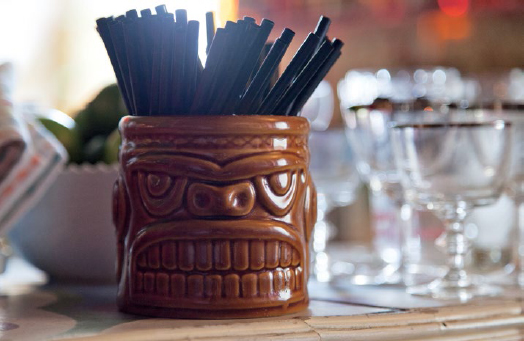
CARIBE WELCOME
Before the piña colada replaced it, this was the signature drink at the Caribe Hilton. Until the mid-1950s, rendering coconut cream was a long and arduous process. Before then it involved sourcing young coconuts, draining the coconut water from them, hacking them open, prying the white flesh from the shells, hand-grinding the flesh to cream it, and then whipping it. Nowadays we would use a food processor, but it’s still easier to buy than make. In 1954, a professor at the University of Puerto Rico automated the process, producing Coco Lopez Coconut Cream, and personally approached chefs and bartenders to encourage them to experiment with his new product. Thanks to the pioneering work of Ramon Lopez y Irizarry, we can enjoy this beverage without having to crack a bunch of coconuts.

COCONUT SHELL
1½ OUNCES GOLD PUERTO RICAN RUM
½ OUNCE APRICOT BRANDY
2 OUNCES COCONUT WATER
½ OUNCE COCO LOPEZ COCONUT CREAM
3 TEASPOONS LIME JUICE
Shake all ingredients over ice. Pour, unstrained, into a coconut shell.
SIBONEY
The Siboney were a native people who lived in the western part of Cuba, pushed there and beyond to Hispaniola by the Taíno people, the main indigenous group of people on Cuba. By around 1600, all the Siboney had died, but their memory lives on. Today, Siboney is a small town and beach near Santiago de Cuba. Ernesto Lecuano used the name for a 1929 song that he wrote about his homesickness when he was away from Cuba. The song quickly became a Cuban classic, and Bing Crosby sang an English version. This recipe, which comes from Trader Vic’s 1974 book Rum Cookery & Drinkery, captures some of the bittersweet longing of the song.

TIKI BOWL
1 OUNCE DARK JAMAICAN RUM
½ OUNCE PASSION FRUIT SYRUP (PAGE 11)
½ OUNCE LEMON JUICE
½ OUNCE UNSWEETENED PINEAPPLE JUICE
Shake all ingredients over ice, and strain into a small tiki bowl.
MISSIONARY’S DOWNFALL
Another Don the Beachcomber original, this recipe hails from the family of Hank Riddle, who worked at several Don the Beachcomber restaurants from the 1940s to the 1980s, according to Jeff Berry in Beachbum Berry Remixed. This frozen tiki treat has the perfect blend of fruit, herbs, sweetness, and acidity—but it packs a punch. As the name suggests, one too many of this delicious drink might prove to be your downfall.

BEER GLASS
2 OUNCES WHITE RUM
½ OUNCE PEACH BRANDY
½ OUNCE HONEY SYRUP (PAGE 11)
1 OUNCE LIME JUICE
4 PINEAPPLE WEDGES (RINDS REMOVED)
6 MINT LEAVES, PLUS EXTRA FOR GARNISH
1 CUP CRUSHED ICE
PINEAPPLE FOR GARNISH
Blend all ingredients, and pour, unstrained, into a beer glass. Garnish lavishly with mint sprigs and pineapple wedge.
ANCIENT MARINER
According to Jeff Berry, the Ancient Mariner is an attempt to re-create the flavors of Trader Vic’s Navy Grog, which was itself an attempt to decipher Don the Beachcomber’s drink of the same name (page 199). Berry created this version, which appeared in his Grog Log.

TIKI BOWL
1 OUNCE APPLETON ESTATE RESERVE RUM
1 OUNCE EL DORADO 12 YEAR RUM
½ OUNCE VANILLA SYRUP (PAGE 11)
¾ OUNCE LIME JUICE
½ OUNCE GRAPEFRUIT JUICE
¼ OUNCE ST. ELIZABETH ALLSPICE DRAM
GRAPEFRUIT FOR GARNISH
Whip shake all ingredients, and strain into a tiki bowl filled with crushed ice. Garnish with a grapefruit wedge.

The ice was here, the ice was there,
The ice was all around:
It cracked and growled, and roared and howled,
Like noises in a swound!
—Samuel Taylor Coleridge,
from “The Rime of the Ancient Mariner” (1834)
SOL Y SOMBRA
Egyptian-born Joe Scialom created this drink after becoming the bar manager at the Caribe Hilton. He later became the beverage superintendent at the Havana Hilton. During his time in the Caribbean, he proclaimed rum to be “the best mixer”—high praise from a man who was at one point Cuba’s most famous bartender. The name means “sun and shadow” in Spanish, and this recipe comes to us from Potions of the Caribbean by Jeff “Beachbum” Berry, who located it in Joe Scialom’s private papers.

PINEAPPLE SHELL
1½ OUNCES GOLD PUERTO RICAN RUM
¾ OUNCE DARK JAMAICAN RUM
½ OUNCE APRICOT BRANDY
2 OUNCES PINEAPPLE JUICE
½ OUNCE LIME JUICE
2 DASHES ANGOSTURA BITTERS
PINEAPPLE SHELL FOR SERVING
Shake all ingredients over ice. Pour, unstrained, into a hollowed-out pineapple. Serve with an umbrella.
Cocteles Cubanos includes a totally different recipe that features the same name:
15 ml aged rum
30 ml crème de cacao
Build in a glass, and serve with a glass of water.
This Sol y Sombra is attributed to José Maria Vazquez, the bartender at the Hotel Lincoln, who created the Mulata Daiquirí (page 136). It was entered in the first cocktail contest held by the Club de Cantineros, where it won an award.
ZOMBIE
Donn Beachcomber infamously instructed of this cocktail: “only two to a customer.” The original recipe remained a mystery until Jeff “Beachbum” Berry uncovered it in a notebook belonging to Beachcomber’s headwaiter Dick Santiago.

COLLINS GLASS
1 OUNCE BARBANCOURT 4 YEAR RUM
1 OUNCE EL DORADO 3 YEAR RUM
½ OUNCE APPLETON V/X RUM
½ OUNCE CORUBA JAMAICAN RUM
½ OUNCE CURAÇAO
½ OUNCE EL DORADO 151 RUM
½ OUNCE PASSION FRUIT SYRUP (PAGE 11)
¼ OUNCE CINNAMON SYRUP (PAGE 10)
¼ OUNCE ORGEAT (PAGE 11)
1 OUNCE LIME JUICE
¾ OUNCE GRAPEFRUIT JUICE
4 DASHES ABSINTHE
4 DASHES ANGOSTURA BITTERS
4 DASHES MARASCHINO
PINEAPPLE, LIME, GRAPEFRUIT, MINT, AND SEASONAL BERRIES FOR GARNISH
Build in a shaking tin, and dry shake. Pour over crushed ice, and garnish with pineapple, lime, grapefruit, mint sprigs, and berries.
Turn the page for more about the genesis of the Zombie.
ZOMBIE
Donn Beachcomber created the Zombie for a friend on his way to the airport who wanted a “tall, cool one” before a flight to San Francisco. Donn mixed five different rums with other ingredients and served it to his friend. The drink went down so well that the friend asked for two more. A few days later, the friend returned, wanting to know what was in that drink. It turns out that after consuming three of them, he got into a fight with his driver, got into an argument on the airplane, and later found himself seated on a San Francisco dock, his feet dangling over the side. The Zombie got its name and its two-drink maximum because the friend felt “like the walking dead.”
The two-Zombie maximum was tested one more time by a local mobster. When the bartender refused the man a third order, the mobster bet Donn one hundred dollars that he could handle at least five without any problems. Beach matched his wager: One hundred dollars said he couldn’t finish even three. A few days later, the man returned to the bar. Beach and the mobster each handed one hundred dollars to the bartender. The mobster drank two Zombies, but halfway through the third his head hit the bar—a knockout. Donn took his winnings and warned the mobster’s companions, “Always remember the Beachcomber’s Rule Number Two: Never bet on another man’s game.”
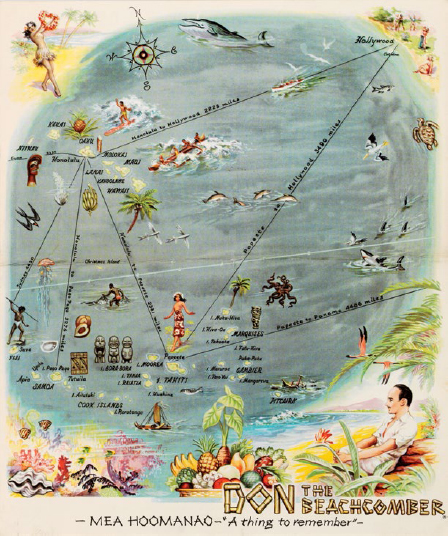
Donn neglected to mention that he had laced the Zombies with glycerin to make sure the mobster never stood a chance.
